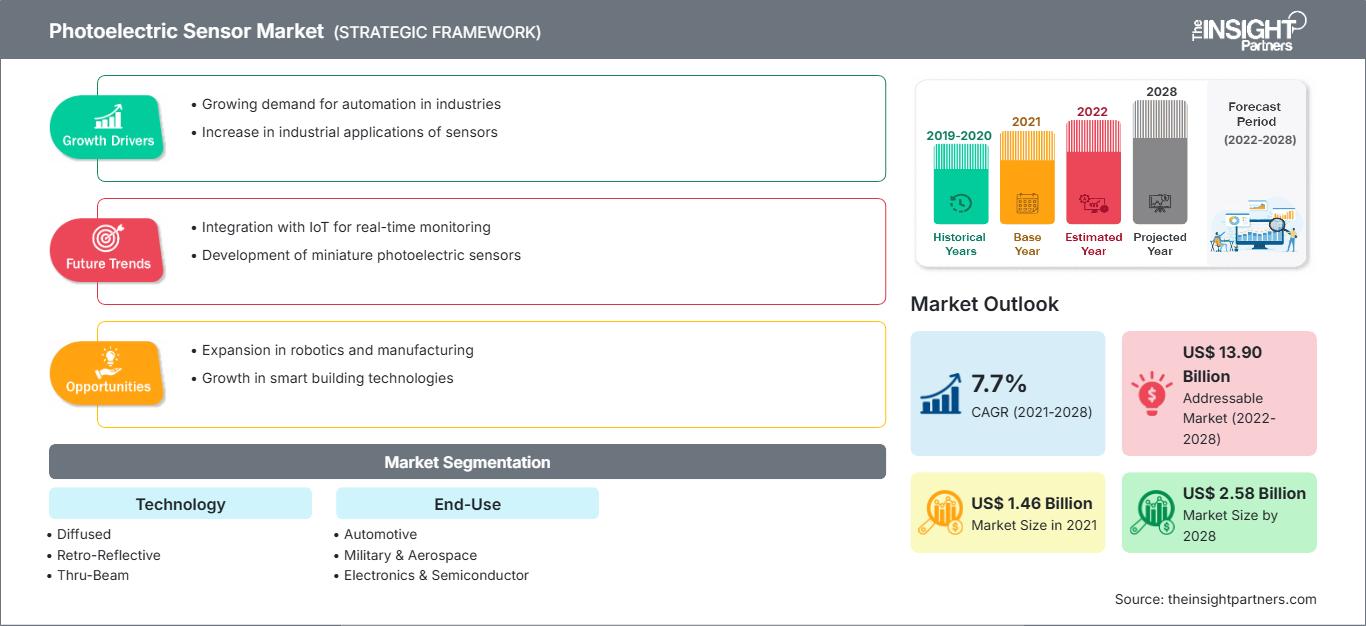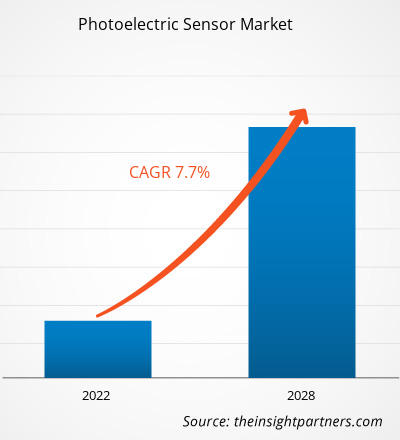[Research Report] The photoelectric sensor market was valued at US$ 1,458.23 million in 2021 and is projected to reach US$ 2,577.56 million by 2028; it is expected to grow at a CAGR of 7.7% from 2021 to 2028.
Photoelectric sensors are gaining popularity due to their high reliability and long-range object detection capabilities, irrespective of the size, shape, color, material, and surface properties of objects. These sensors are designed to operate under harsh conditions; moreover, they are enabled with advanced technologies to ensure reliable suppression of undesirable reflections. These abilities makes them more versatile than many other sensor types and appropriate for industrial usage. For instance, retro reflective sensors with polarization filters detect the position of carriage of any shape and material, which is to be kept on and off the track of a rollercoaster. Further, photoelectric sensors are widely used in the military and aerospace industries owing to their high accuracy and reliable performance. They are used in cargo aircraft for smoke and fire detection. In addition, photoelectric sensors help airframe and engine manufacturers to monitor aerospace system parameters such as pressure, temperature, acceleration, optical position, and speed. Moreover, the defense industry is extensively using biological detection equipment for detecting the presence of chemical substances in environment and for assessing the risk of potential biological threats by detecting harmful biological materials, to safeguard both military and civilian populations. Thus, the accuracy and reliability of photoelectric sensor operations make them a preferred sensor type in harsh industrial conditions.
Impact of COVID-19 Pandemic on Photoelectric Sensor Market
According to the latest report from the World Health Organization (WHO), the US, Spain, Italy, France, Germany, the UK, Russia, Turkey, Brazil, Iran, and China are among the worst-affected countries due to the COVID-19 outbreak. In 2020, the world economy suffered significant consequences, and the effects are expected to endure to some extent in coming years. The outbreak disrupted primary industries such as electronics, semiconductor, and manufacturing. A sharp decline in the growth of these industries is limiting the growth of the photoelectric sensor market. Factory shutdowns, travel and trade bans, and border lockdowns to combat and contain the infection have negatively impacted manufacturing, supply, and sales of various sensor products.
Customize This Report To Suit Your Requirement
You will get customization on any report - free of charge - including parts of this report, or country-level analysis, Excel Data pack, as well as avail great offers and discounts for start-ups & universities
Photoelectric Sensor Market: Strategic Insights

-
Get Top Key Market Trends of this report.This FREE sample will include data analysis, ranging from market trends to estimates and forecasts.
Manufacturers of photoelectric sensors are focusing on lowering operating costs to stay competitive. However, they are expected to resume production activities during the post-lockdown phase. Government initiatives to boost economies and relaxations in the lockdowns are expected to fuel demand for photoelectric sensors during the forecast period. Demand for photoelectric sensors is likely to expand as new technologies become more widely adopted in the automotive and aerospace industries.
Photoelectric Sensor Market Insights
Rising Demand for Photoelectric Sensors in Pharmaceuticals Industry Drives Growth of Photoelectric Sensor Market
Pharmaceutical companies focus on improving their overall manufacturing operations by avoiding discrepancies such as empty packaging, which can be caused due to the unavailability of medicine tablets on the production line. The industry is increasingly deploying photoelectric sensors for tablet counting, bottle filling, and count verification (in clinical trials). These sensors are also being used in automated prescription fulfillment machines at retail pharmacies and hospitals. Further, advancements in photoelectric sensors in terms of their sensing range, which is improving their counting accuracy, along with maintaining a hygienic production environments by excluding human contacts while packaging of medicine are the benefits associated with photoelectric sensors. Also, photoelectric sensor provides a cost-effective solution, which is attained through automatic production line in the pharmaceutical industry. Hence,
the surge in the adoption of photoelectric sensors in pharmaceutical companies is mainly attributed to their abilities to enhance efficiencies, reduce industry’s operational costs, and facilitate real-time production monitoring. These sensors automate the upper and lower levels of liquid measurement in jar or tank. The use of strong corrosive chemicals (acidic or basic) is commonplace in pharmaceutical companies, and thus, the detection of liquid levels in storage tanks is an important task in these plants. Thus, increasing use of photoelectric sensors in the pharmaceuticals industry would drive the photoelectric sensor market growth in the coming years.
Technology-Based Market Insights
Based on technology, the photoelectric sensor market is segmented into diffused, retro-reflective, and thru-beam. In 2020, the retro-reflective segment accounted for the largest share in the market.
End-User Based Market Insights
Based on end-user, the photoelectric sensor market is segmented into automotive, military and aerospace, electronics and semiconductor, packaging, and others. In 2020, the automotive segment accounted for the largest market share.
The players operating in the photoelectric sensor market adopt strategies such as mergers, acquisitions, and market initiatives to maintain their positions in the market. A few developments by key players are listed below:
- In April 2020, Balluff Photoelectric Sensors provided condition monitoring data. The smart automation and monitoring systems (SAMS) portfolio includes solid photoelectric sensing, condition monitoring, and advanced IO-link technologies, all of which are meant to save downtime by making troubleshooting, changeover, and machine setup easier.
- In February 2020, Eaton Corp plc listed among world's most admired company in 2020 by Fortune magazine.
The regional trends and factors influencing the Photoelectric Sensor Market throughout the forecast period have been thoroughly explained by the analysts at The Insight Partners. This section also discusses Photoelectric Sensor Market segments and geography across North America, Europe, Asia Pacific, Middle East and Africa, and South and Central America.
Photoelectric Sensor Market Report Scope
| Report Attribute | Details |
|---|---|
| Market size in 2021 | US$ 1.46 Billion |
| Market Size by 2028 | US$ 2.58 Billion |
| Global CAGR (2021 - 2028) | 7.7% |
| Historical Data | 2019-2020 |
| Forecast period | 2022-2028 |
| Segments Covered |
By Technology
|
| Regions and Countries Covered |
North America
|
| Market leaders and key company profiles |
|
Photoelectric Sensor Market Players Density: Understanding Its Impact on Business Dynamics
The Photoelectric Sensor Market is growing rapidly, driven by increasing end-user demand due to factors such as evolving consumer preferences, technological advancements, and greater awareness of the product's benefits. As demand rises, businesses are expanding their offerings, innovating to meet consumer needs, and capitalizing on emerging trends, which further fuels market growth.

- Get the Photoelectric Sensor Market top key players overview
The global photoelectric sensor market has been segmented as mentioned below:
By Technology
- Diffused
- Retro-Reflective
- Thru-Beam
By End-User
- Automotive
- Military and Aerospace
- Electronics and Semiconductor
- Packaging
- Others
By Geography
- North America
- US
- Canada
- Mexico
- Europe
- France
- Germany
- Italy
- UK
- Russia
- Rest of Europe
- Asia Pacific (APAC)
- China
- India
- South Korea
- Japan
- Australia
- Rest of APAC
- Middle East & Africa (MEA)
- South Africa
- Saudi Arabia
- UAE
- Rest of MEA
- South America (SAM)
- Brazil
- Argentina
- Rest of SAM
Company Profiles
- Autonics Corporation
- Balluff GmbH
- Eaton Corporation plc
- Ifm Electronic GmbH
- Keyence Corporation
- OMRON Corporation
- Rockwell Automation, Inc.
- Panasonic Corporation
- SICK AG
- Schneider Electric SE
Frequently Asked Questions
Which product is expected to dominate the market in the forecast period?
What are reasons behind Photoelectric Sensor market growth?
What are market opportunities for Photoelectric Sensor market?
- Historical Analysis (2 Years), Base Year, Forecast (7 Years) with CAGR
- PEST and SWOT Analysis
- Market Size Value / Volume - Global, Regional, Country
- Industry and Competitive Landscape
- Excel Dataset
Recent Reports
Related Reports
Testimonials
Reason to Buy
- Informed Decision-Making
- Understanding Market Dynamics
- Competitive Analysis
- Identifying Emerging Markets
- Customer Insights
- Market Forecasts
- Risk Mitigation
- Boosting Operational Efficiency
- Strategic Planning
- Investment Justification
- Tracking Industry Innovations
- Aligning with Regulatory Trends





















 Get Free Sample For
Get Free Sample For